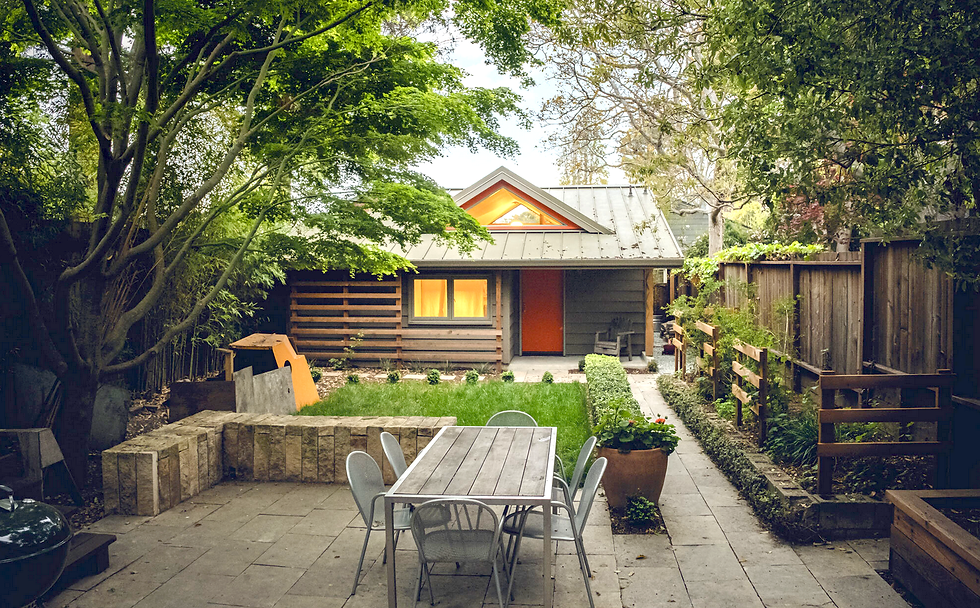The Potential of ADUs
- wbdesignloop
- Jul 1, 2021
- 5 min read

The Potential of ADUs
By Chloe Chapman,
As you might have heard, California’s residential housing market has a new legal entrant: the Accessory Dwelling Unit or ADU, also known as an in-law unit, granny flat, casita, or garage conversion.
California legislation had slowly been eliminating the hurdles to developing these structures, but on January 1st, 2020 the State issued legislation that removed almost all of the barriers. It eliminated some land use and zoning restrictions, removed lot size and parking requirements in most cases, and limited setbacks to four feet maximum. Municipalities scrambled to adjust their local ordinances, and builders had to learn new techniques and codes.
What is particularly interesting about ADUs is their potential to help address the multiple crises we face in the Bay Area. Climate change is creating extreme weather patterns, reducing rain and snowfall and increasing the severity of wildfires. Social injustice and inequity have increased dramatically. And to top it all off, we have a significant housing shortage. The built environment plays an important role in, and is impacted by, all of these crises. Given what is at stake for our communities and our planet, we believe we need to work creatively and collectively to make real, long-term, effective change for the health, wellness, and vitality of individuals, communities and bioregions. ADUs are a great place to begin this work and think differently about how we design and build homes, given their smaller footprint that allows them to be built in areas that have existing services, encourage sustainable forms of transport and use less resources while being accessible to more people because of their smaller size. ADUs are leading to new types of construction, technology, and opportunities for builders, homeowners and advocates. ADUs are sometimes pre-fabricated as kits for assembly-in-place. They are sold as products, flat-packed like Ikea furniture, and shipped to your door, like with Kanga Room Systems. Some of those allow customization so owners or designers can get exactly the shape, size, and details they desire. Computer-controlled robotic machines might cut plywood panels made-to-order, or 3D print plastic components on demand, as they do at Mighty Buildings. New technologies allow different kinds of efficiency, saving manufacturing time or on-site manual labor, and reducing material wastes. ADU fabricators are integrating that new technology to meet needs and demands of their customers. Coding and robotics jobs that didn’t previously exist are growing in the construction industry, and widen the recruiting pool to many not previously interested or able to meet the more physical demands of construction. The traditional construction workforce in California is aging, and is not large enough or growing fast enough to keep up with demand for more housing. Automation will not only increase the rate new homes can be manufactured, but may also reduce some of the more dangerous tasks in homebuilding, which makes it a more appealing industry and career path. With the rising cost of homeownership, especially in California, ADUs offer a path to wealth-building and gracefully aging in place. For existing homeowners, ADUs can be built as an additional unit to rent out, or provide flexible space as more people are working from home or caring for elderly and children. There are new ownership models, available through organizations like OBY Cooperative, that allow homeowners to rent their backyards to cooperatives so they can collect extra income, without the upfront cost and responsibility of building and renting an ADU. And there are new investment opportunities, offered through platforms like Small Change, that allow for non-traditional real estate projects to get financed through crowd-funding, now open to many who have been traditionally excluded from real estate investing and wealth-building opportunities.
In addition to all the innovative approaches to building automation, many ADUs are still built with traditional wood frame construction. One advantage of this approach is the ability to customize to the needs of a family and site. Another is approachability, as this size and scale of project can allow for DIY. There are collectives, like LATCH Collective, providing home building workshops to help reduce the labor costs and provide skill-building for homeowners to be more hands-on with the construction and maintenance of their own homes. This not only aids individuals but strengthens communities with resilience and transferable skills, as one person teaches the next, tools and expertise get exchanged, homes get repaired, and social networks grow.
And there are organizations and advocates on the city, county and state level working to bring education, financial products, and resources to people thinking about owning or living in an ADU. One leader in this space is the Casita Coalition, bringing together organizations and people to advocate for ADUs. Another is the Napa Sonoma ADU Center, which was specifically started to provide how-to resources to help people understand and prepare for all that is involved with the ADU process, empowering them to make informed decisions. San Mateo County created a calculator tool to help homeowners with financial planning, and is encouraging other local governments to customize the tool for their own residents. Cities are playing match-maker to help renters find available ADU units, and local credit unions are creating financial products specifically for ADUs, with added incentives to make new housing stock affordable to vulnerable communities
If we work collectively and intentionally to develop accessory dwelling units, we will do so much more than provide basic shelter or additional AirBnBs. We can create accessible, healthy, comfortable, and environmentally-friendly homes. We can foster a diverse, intergenerational community, embedded in existing neighborhoods, close to transit and services. We can support local workforce development and wealth-building opportunities, and allow members in the community to gracefully age in place.
California is still very much in the early stages of realizing the potential of these building types. Build It Green (see details below) brought together people from across the ADU ecosystem — builders, architects, city officials, data analysts, financial officers, and the people that live in, own, and rent ADUs — to explore these ideas. Tune in to discover how we might transform our communities, and larger building culture, from this foundation in Build It Green’s Potential of ADUs Series.
About Build It Green:
Build It Green, a 501(c)3 nonprofit organization based in Oakland, CA, has been a building culture catalyzer for more than 15 years. BIG built its reputation on bringing residential green building practices into the mainstream with credible, accessible resources and innovations including the GreenPoint Rated home certification program. Today, Build It Green is working with diverse coalitions to envision new approaches to home and neighborhood building that foster health in the broadest sense — as an interconnected web of personal, community, and bioregional well-being.
photo credits: Building an ADU, Mighty Buildings, Todd Jersey Architecture, McGlashan Architecture, HDR Remodeling, Mikiten Architecture
























Comments